Barcelona’s Jordi Alba, Marcelo of Real Madrid, Lucas Digne, and David Alaba are just a few full-backs who are famous for their typical sprints down the touchline to support their wingers with overlapping runs. Nowadays, overlapping runs are a tactical pattern which is used extremely often, especially by squads who dominate their opponents and mainly face teams who try to defend in a low-block and so they often try to break up the opposition’s formation with the aid of overlapping runs.
In this tactical analysis, I’ll explain why overlapping runs can be an important part of a team’s tactics, talk about the aspects which the players need to understand, and then show you three drills which can help you as a coach to practice overlapping runs with your team.
The importance of overlapping runs
We saw several times within the last couple of years the same scenario in many Barcelona games: Alba overlaps the left-winger, gets the ball and delivers a low cross towards Lionel Messi who then scores. Now, of course, not every team has got a player on the level of Messi in their squad who is incredibly talented in finding free spaces in these situations to receive the ball and then strike it home.
However, with the right explanation and some practising, an overlapping run can be done by almost every full-back and it’s hard for every single defence to defend against. But before we talk about what exactly the players need to understand or in which situations these tactics can be useful, I want to make clear why overlapping runs can massively help a team.
We’ll start now from scratch. As everyone knows, the goal of every single game must be to win it and due to that that we want to score goals. To do so, we must create situations in which we use tactics and patterns (or an individual action) to bring a player into a position in which he can score a goal. An effective way to get there is to force your opponents to make decisions. Whenever you can bring one, or ideally several, opposition players into situations in which they have to decide between two or even more options, they will make mistakes which will probably lead to something.
Generally, you can provoke such situations with movements and runs, and an overlapping run is one of the preferred ones since it’s on the wing and there are neither many players nor many opponents involved which makes it easier to practice it.
The raw and basic idea is illustrated in the image below. The player on the ball (mainly a winger) finds himself in a one-on-one situation on the wing against an opponent (mainly a full-back). As he gets supported by a teammate who makes an overlapping run, the player on the ball has three options which are all shown in the graphic in three different colours. He can pass the ball down the line, he can cut in to the play the ball through (both times to the overlapping player), or he can cut in and do something else like a dribble, a pass, or a shot.
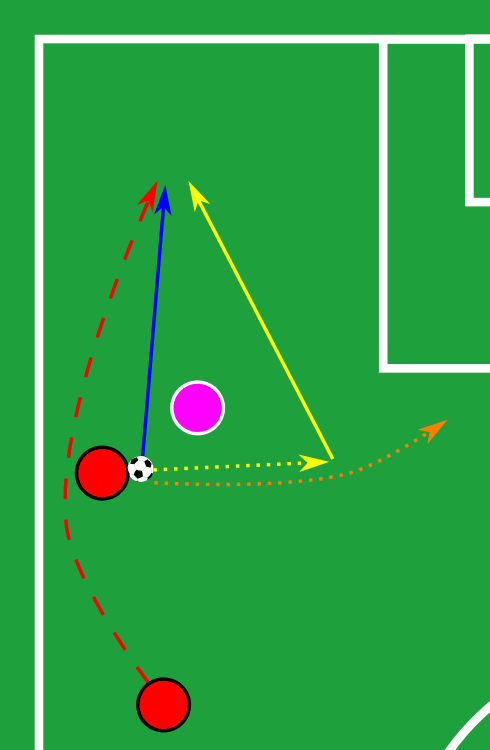
Now, as a consequence, the defender also has several options for how he could defend this situation. So we force him to make a decision as he could follow the player who makes the overlapping run or stay near the one on the ball. It’s not possible for a defending player to always take the right option and he will make mistakes which can lead to a dangerous situation. Two players who were outstanding in such situations were Arjen Robben and Philipp Lahm back in the years when they played together on the right side of Bayern Munich.
Of course, in some situations it’s also the goal to even create a one-on-one situation as the player on the ball is usually facing two opponents and then the overlapping player pins one opponent which creates a new situation. But we can see that the basic idea is always to support the player on the ball by providing an additional option and forcing the opponent to a decision or create a new situation.
What the players need to understand
As almost everything else in football, this only works when all players (especially the one who makes the overlapping run) are working with the highest possible intensity. The main reason for that is that this movement can get even more effective when the player runs with the maximum speed.
Since the defender(s) are either standing still or not in a sprint, they will need a few yards to pick up the full speed while the overlapping player is already as fast as he can be since he started from a deeper position. Due to that, an important part of the coaching is also to make it clear to the players that it can be an advantage in these situations if they are positioned deeper since then they have some yards to pick up speed.
Also, we mostly see full-backs who make overlapping runs since they are in a good position to do so. However, in truth, other players can also make this run – especially central midfielders who could do them way more often. The reason for that is simple: while full-backs will be followed by the opposition’s wingers when they sprint forward, not every central midfielder will mark and follow his direct opponent when this one drives to the outside and overlaps the winger.
Furthermore, an important point of the coaching besides the timing is that the player on the ball needs to detect the overlapping run early enough to dribble inside to give the teammate time to overlap and open up space in his back since otherwise, this pattern will not work. In the next parts of this coaching and tactical analysis, we’ll look at three drills which can be used to practice overlapping runs.
First practice
One of the most discussed question in the world of football coaches is indeed if you should use isolated drills, or just play games with additional rules and variations of forms of the field(s) and the number of the players.
The truth is probably in between, and we won’t discuss this question in further detail in this analysis. However, especially when you are a coach of a youth team, it’s often necessary to start with an isolated drill in which the players should get used to the movements and the pattern of the overlapping run in general.
They need to get used to the timing of when to start the run and when to play the ball and also the feeling to when cut inside to open up the space on the wing. Due to that, if you are coaching a senior team it’s likely that all players know these tactics and so this first practice is not always necessary. In any case, I still wanted to include it in this tactical analysis since sometimes it’s needed, so the players get a feeling for it.
You can have several adjustments here, but this is the cleanest and simple drill to get your players used to the drill. Player A passes the ball to player B who dribbles inside to upon up the space behind him in which player C sprints and receives a pass. He then delivers a cross towards his two teammates.
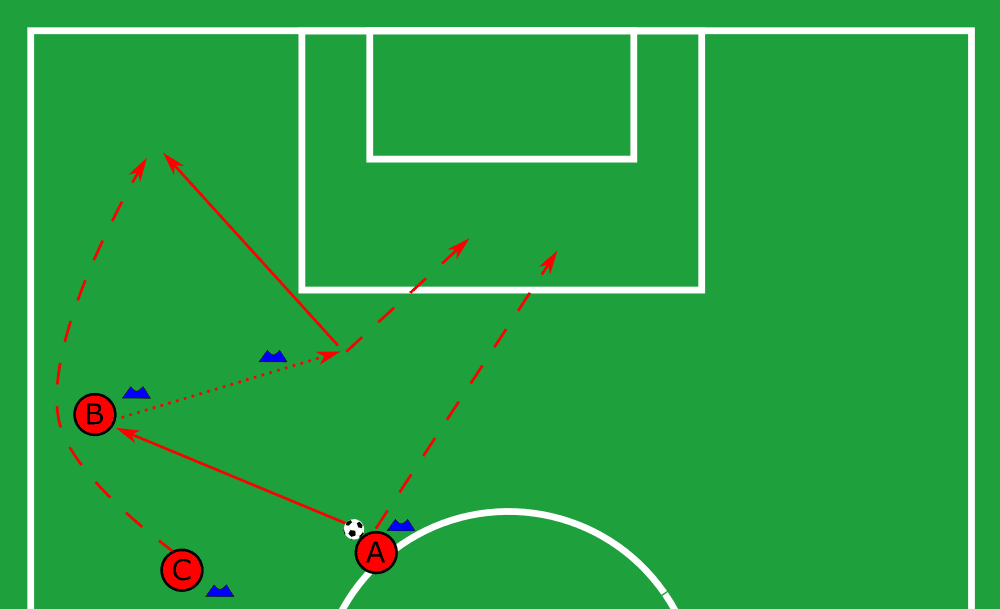
You can add an extra combination ahead of that pass to the wing or let player A be the one who starts the overlapping run (when you want in the game your central midfielders to make this movement). The most important factor here is probably to avoid the players standing still for too long and that they are always moving and having the ball at their feet. For that, make the same drill on the other side and once the attack went down on the one side, the other one can start.
Additionally, encourage your players to talk to each other and tell the overlapping players to give the player on the ball a shout when they should play the pass to avoid an offside.
Second practice
Since the first drill was an isolated and static one and the third one will be a game with additional rules, this one will be somewhere in between. In the game, players will have to be aware of so many circumstances and have to detect several changes and movements on the pitch every second. Meanwhile, in the first practice, everyone knows exactly the patterns and what they should do.
Due to that, we create now a situation in which players have a similar pressure like in the actual game, but this time, they have fewer opponents and teammates. Considering that, we take a little part out of the game and put them in a 3 v 2 situation which the three players need to solve with an overlapping run to get in the final third as we can see below.
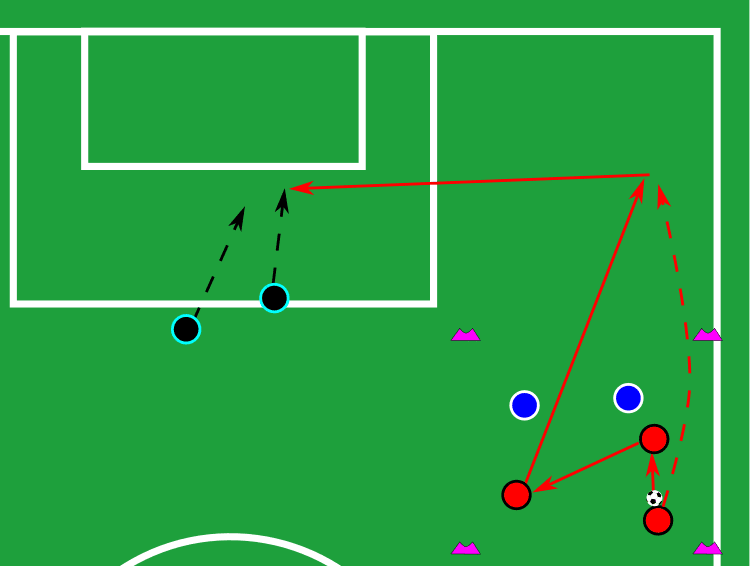
Due to the small number of players, it’s easier for them to execute the overlapping runs where they again get a better feeling for the whole pattern and the single movements. You can vary and find different ways to position players in the centre for the cross. For example, we have on both sides of the pitch this drill and after every sequence, the two defenders come in the following round on the other side of the two strikers and position themselves at the edge of the box. So, you can switch the roles in every round and the players are always in a different role.
Also, you can do instead of a 3 v 3 in the field since in the 3 v 2 the drill would be over when the two defenders win the ball. A 3 v 3 is more likely in the game as both teams permanently have to defend and attack. In the shot below we can see for example on both wings a 3 v 3 and as soon as the drill on one side is over, the defenders go into the centre for the cross from the other side and the attackers become defenders against the next group.
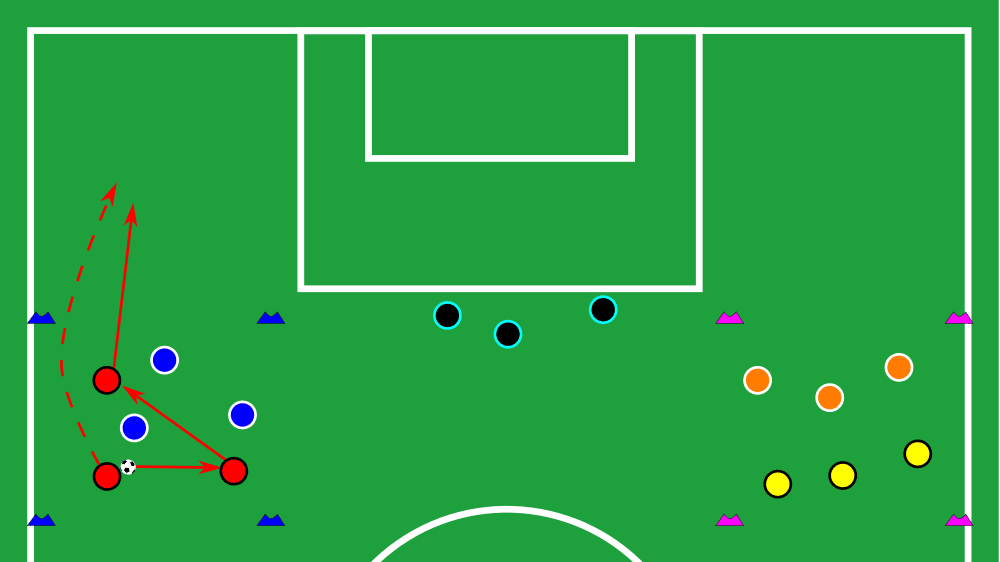
Third practice
This will be the third and last drill which we talk about in this tactical and coaching analysis. As we now got one static and one more dynamic practice, we will now look at a game with additional rules. The first thought would probably be to divide the pitch (the size can vary and should be adjusted to the number of players) into three vertical zones and make the outer ones a bit smaller than the one in the middle. As soon as a player in the space on the wing gets on the ball, a teammate makes an overlapping run, gets the ball and delivers a cross which leads to a goal, and their team will then get three points for this goal.
However, with the aid of this drill, you would take away the special aspect of the overlapping run: forcing the defender to make a decision. Since the defender knows that this kind of attack will bring his opponents more points, he will mainly defend this option and that’s not how it will be in the actual game.
Because of that, we adjust the rule and make the following. As soon as a player in the wider zones gets on the ball and a teammate starts an overlapping run:
- They get two points if the player cuts in and scores
- They get three points if he cuts in and makes an assist
- They get four points if he plays the ball to the overlapping player and this leads to a goal
How many points and which kind of goal counts depends on the preferred way of how the coach wants his team to attack down the wing, or probably also how the upcoming opponent usually defend in such situations.
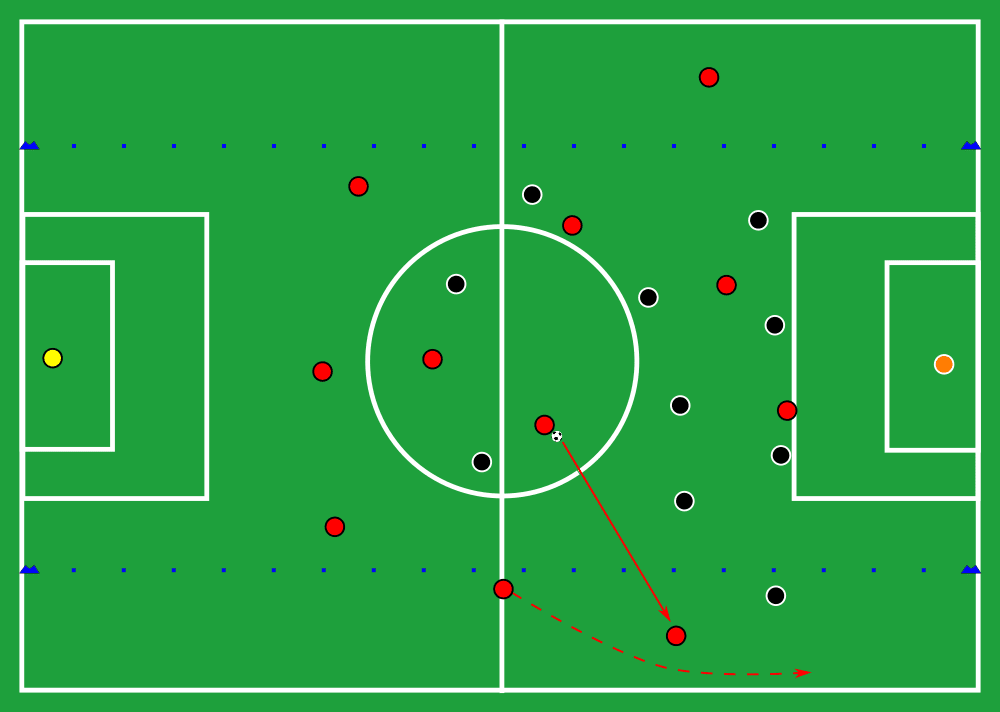
Still, another thing to focus on in this drill is the coaching the timing of the run and when the player on the ball should dribble to the inside to give the overlapping player time and space.
Conclusion
After these three drills, your players should get a feeling for the overlapping runs. A good sign that the players understood what you want from them is when you play at the end of the training (in which you used one or more of these drills) a game without any additional rule, and they start to execute the overlapping runs.
Clever players will understand the impact these movements can have and will execute them without any additional rule. You should also watch in a training game which players start the overlapping run (and from which position) without any call from the coach. By just looking at the player’s positioning and movement when the winger receives the ball, you can see what your players already understood and how they interpret the new pattern.





Comments